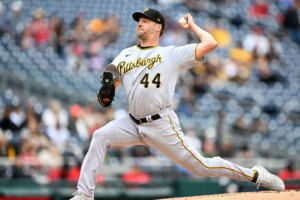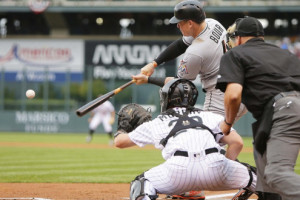Risers and Fallers: Volume 3
![]()
I’m excited to be back for another week of Risers & Fallers! Each week, I’ll break down a handful of players using advanced metrics, my DFS projection system (THE BAT, available in the RotoGrinders Marketplace), and insights from my scouting background. I’ll examine guys whose stock is going up, guys whose stock is going down, guys who are perpetually underpriced or overpriced, guys who are worth paying a premium for, or guys who are just interesting and warrant some analysis on.
If you guys have any suggestions for who you’d like to see in future articles, feel free to let me know.
Falling… And This is My Sad Face :(
Rich Hill, SP, Los Angeles Dodgers
Outside of Clayton Kershaw and Alex Wood, Rich Hill is my favorite pitcher in baseball. Yeah, yeah, I like Dodgers pitchers. Sue me. (Actually, Lance McCullers and his absurd curveball is my favorite pitcher, but listing Dodgers pitchers works better narratively speaking. Sue me again.) Unfortunately, we’re looking at a completely different version of Rich Hill this year… one who’s own curveball doesn’t look nearly as nasty as it did one year ago. And it makes me really sad.
When most people think of curveballs, they think of the pitch that hitters are off-balance trying to attack and swing right over the top of. Rich Hill’s curveball, however, is not and has never been one that relies on the kind of big swing-and-miss numbers we might assume it would based on his gaudy strikeout rates. The kinds of curveballs that work best for swinging strikes are the kind Wood and McCullers throw. The hard, tight curves that don’t move a whole lot overall, hide inside the pitcher’s fastball for most of the trajectory, and then fall off the table at the last minute—ideally low in the zone so hitters have no chance at it, even though they think they do because they don’t realize that it’s actually a curveball until it’s too late.
Hill’s curveball is the opposite. It generates a ton of movement, doesn’t hide inside the fastball at all, and is worked high in the zone—which technically breaks the cardinal rule of breaking balls. High breaking balls are “hanging” pitches, but few would ever say Hill hung his curves last year despite a 29% high percentage—good for third in baseball among those who threw at least 150 of them (behind Steven Wright, a knuckleballer, and Anibal Sanchez, the Almanac-certified worst pitcher in baseball).

It can be a fine line to walk, but curveballs can not only work high in the zone but can thrive given the right attributes. They don’t generate many whiffs, but they can freeze hitters for called strikes. And Hill’s was one of the best. The second best curveball for called strikes from 2015 to 2016, according to my pitcher “stuff” system I previously discussed, and right near the top in terms of actual results.
The problem is that this year, many of the things that have made Hill’s curveball effective have diminished. The pitch is moving a bit less. The difference in its movement from the fastball is diminished (important for messing with the hitters’ eye level). It’s getting less of that arc that lets Hill drop it into the top of the zone for a strike. And it’s getting less late break on the tail end of that arc. The pitch certainly isn’t a lot worse, but it is most definitely worse. Hitters are offering at the pitch up in the zone more often (i.e. not letting it fall in for called strikes), and while samples are very small, they do appear to be hitting it harder. It’s a little extreme to call Hill’s breaking ball a hanger, but that certainly appears to be some of the effect we’re seeing. According to Brooks Baseball, the ISO on Hill’s curve has doubled since last year, and the HR rate on it has nearly tripled. Plus, hitters are teeing off more on the fastball too, which is down a full 2 mph.
Eno Sarris recently wrote a piece at FanGraphs on how Hill’s curveball is the likely cause of the blister problems he’s been having since last year. He’s been on the DL twice already this year with the issue, so perhaps not only is curveball affecting the blisters, but maybe the blisters are affecting the curveball. Or maybe it’s plain old aging; Hill is 37 years old, after all. Either way, this isn’t the same Rich Hill I came to love the past two years—years in which he posted elite walk rates in addition to elite strikeout rates. His walks have ballooned this season, however, back to the exorbitant levels they were at early in his career when his stuff showed monster promise but he couldn’t find the strike zone. Maybe this is blister related too. Either way, I’ll be wary of Hill going forward, particularly given how few pitches he tends to throw as the Dodgers try to work around the blisters (he cracked 90 pitches for the first time all year in his most recent start).
Rising… But Still Maybe Not Cash-Game Playable
Justin Bour, 1B, Miami Marlins
There was an interesting Twitter conversation last week between a bunch of DFS players in regard to Justin Bour. TheSeige contested that Bour has become a top-35 hitter in baseball. At first, I outright laughed at the notion. In a 12-team season-long league, a top-35 hitter is a fourth round pick. This year, the fourth round consisted of players like Yoenis Cespedes, Wil Myers, and Chris Archer. It’s just not possible that Bour is on this level.
Then I got curious, remembered assumptions are terrible and I’m better than that, and actually started digging into the numbers. When I did, I found that the notion really isn’t as crazy as it initially sounds.
At present, THE BAT projects Bour for an underlying, context-neutral .362 (!) wOBA. At the start of the year, if memory serves, he was somewhere around .330. That’s a huge jump in a true talent estimate in just two months, in all likelihood one of the largest of any players this year.
So what is Bour doing this year? Well, he’s hitting the ball really, really hard. Really hard. He’s posted a .403 wOBA, good for 18th among qualifiers, and most of that is tied up in power. His non-power stats are actually nothing special. His strikeout rate is back up above average at 23% after it fell to 17% last year. His walk rate is above-average but stable. And his BABIP is a career-high .320—which is a bit above average and will regress, but not too terribly far.
His home run rate, though, is 2.4 times league average. Last year, it was just 1.5 times league average. This is made more impressive by a home park that suppresses home runs for lefties by about 13% and is the second-worst park in baseball for left-handers overall. His overall mix of parks this year suppresses homers for lefties by about 9%.
His hard hit rate is 1.51 times league average, up from 1.12 times league average last year. In more understandable terms, he’s making hard contact nearly 50% of the time he contacts the ball. That’s an insane figure. It will almost certainly drop, but Bour’s power surge appears to be pretty legit.

So where does Bour’s .362 projected wOBA in THE BAT rank him among his peers? Does he crack the top-35? Why yes, yes he does, coming in at 34th overall. A couple days ago, I never would have thought that possible, but Bour is having a sneakily excellent year. Of course, he does call Marlins Park home, which means for practical purposes he’s not 34th best overall, that his .362 wOBA projection would be significantly less in home games—maybe more like .342. When you account for the context he’ll face going forward, he’s probably more in the 50-60 range. But the underlying talent is there, particularly against bad righties on the road (yes, bad righties. More on this in a minute).
That’s not to say I’ll be running to play Bour, since he is a first baseman after all. The bar for first basemen is the highest of any position in baseball. There are so many elite, elite players, that even if we concede Seige’s point (which I’m more than willing to), it will still be tough to find a spot for Bour in cash games. Of the 33 better hitters, according to THE BAT, nine are fellow first baseman. And Bour hits in a mediocre Marlins lineup, which means he lacks the same kind of RBI and run potential that guys like Paul Goldschmidt and Edwin Encarnacion and Miguel Cabrera have.
One other thing to note: Bour is showing extreme reverse splits this year, destroying lefties while merely being okay against righties. This is not something you should expect to continue. As I’ve said many, many times before, platoon splits are noisy. Bour has never shown this kind of split before, always hitting righties better (as we’d expect), which means we are almost certainly just dealing with noise. The improvement against lefties he’s showing is a good sign for his staying power, but under no circumstances should you actively target lefties with Bour. Going forward, the mathematical chances of him continuing hit them better than righties is miniscule.
But all things considered… and I can’t believe I’m saying this… TheSeige does appear to have some very solid ground to stand on. I’ll have to find something else to rip him on the next time we’re on GrindersLive together. Sighhhhh…